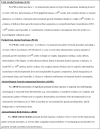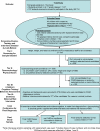Approaching the prevalence of the full spectrum of fetal alcohol spectrum disorders in a South African population-based study
- PMID: 23241076
- PMCID: PMC3610844
- DOI: 10.1111/acer.12033
Approaching the prevalence of the full spectrum of fetal alcohol spectrum disorders in a South African population-based study
Abstract
Background: The prevalence and characteristics of fetal alcohol spectrum disorders (FASD) were determined in this fourth study of first-grade children in a South African community.
Methods: Active case ascertainment methods were employed among 747 first-grade pupils. The detailed characteristics of children within the continuum of FASD are contrasted with randomly selected, normal controls on (i) physical growth and dysmorphology; (ii) cognitive/behavioral characteristics; and (iii) maternal risk factors.
Results: The rates of specific diagnoses within the FASD spectrum continue to be among the highest reported in any community in the world. The prevalence (per 1,000) is as follows: fetal alcohol syndrome (FAS)-59.3 to 91.0; partial fetal alcohol syndrome (PFAS)-45.3 to 69.6; and alcohol-related neurodevelopmental disorder (ARND)-30.5 to 46.8. The overall rate of FASD is therefore 135.1 to 207.5 per 1,000 (or 13.6 to 20.9%). Clinical profiles of the physical and cognitive/behavioral traits of children with a specific FASD diagnosis and controls are provided for understanding the full spectrum of FASD in a community. The spectral effect is evident in the characteristics of the diagnostic groups and summarized by the total (mean) dysmorphology scores of the children: FAS = 18.9; PFAS = 14.3; ARND = 12.2; and normal controls, alcohol exposed = 8.2 and unexposed = 7.1. Documented drinking during pregnancy is significantly correlated with verbal (r = -0.253) and nonverbal ability (r = -0.265), negative behaviors (r = 0.203), and total dysmorphology score (r = 0.431). Other measures of drinking during pregnancy are significantly associated with FASD, including binge drinking as low as 3 drinks per episode on 2 days of the week.
Conclusions: High rates of specific diagnoses within FASD were well documented in this new cohort of children. FASD persists in this community. The data reflect an increased ability to provide accurate and discriminating diagnoses throughout the continuum of FASD.
Copyright © 2012 by the Research Society on Alcoholism.
Figures
References
-
- Achenbach TM, Rescorla LA. Manual for the ASEBA School-Age Forms and Profiles. University of Vermont, Research Center for children, Youth, & Families; Burlington, VT: 2001.
-
- Adèr HJ, Mellenbergh GJ, Hand DJ. Advising on Research Methods: a Consultant's Companion. Johannes van Kessel Publishing; Huizen, The Netherlands: 2008.
-
- Alvik A, Haldorsen T, Lindemann R. Alcohol consumption, smoking and breastfeeding in the first six months after delivery. Acta paediatrica. 2006;95:686–693. - PubMed
-
- Armstrong EM. Conceiving Risk, Bearing Responsibility: Fetal Alcohol Syndrome and the Diagnosis of Moral Disorder. The Johns Hopkins Press; Baltimore, Maryland: 2003.
Publication types
MeSH terms
Grants and funding
LinkOut - more resources
Full Text Sources
Medical
Research Materials
Miscellaneous



